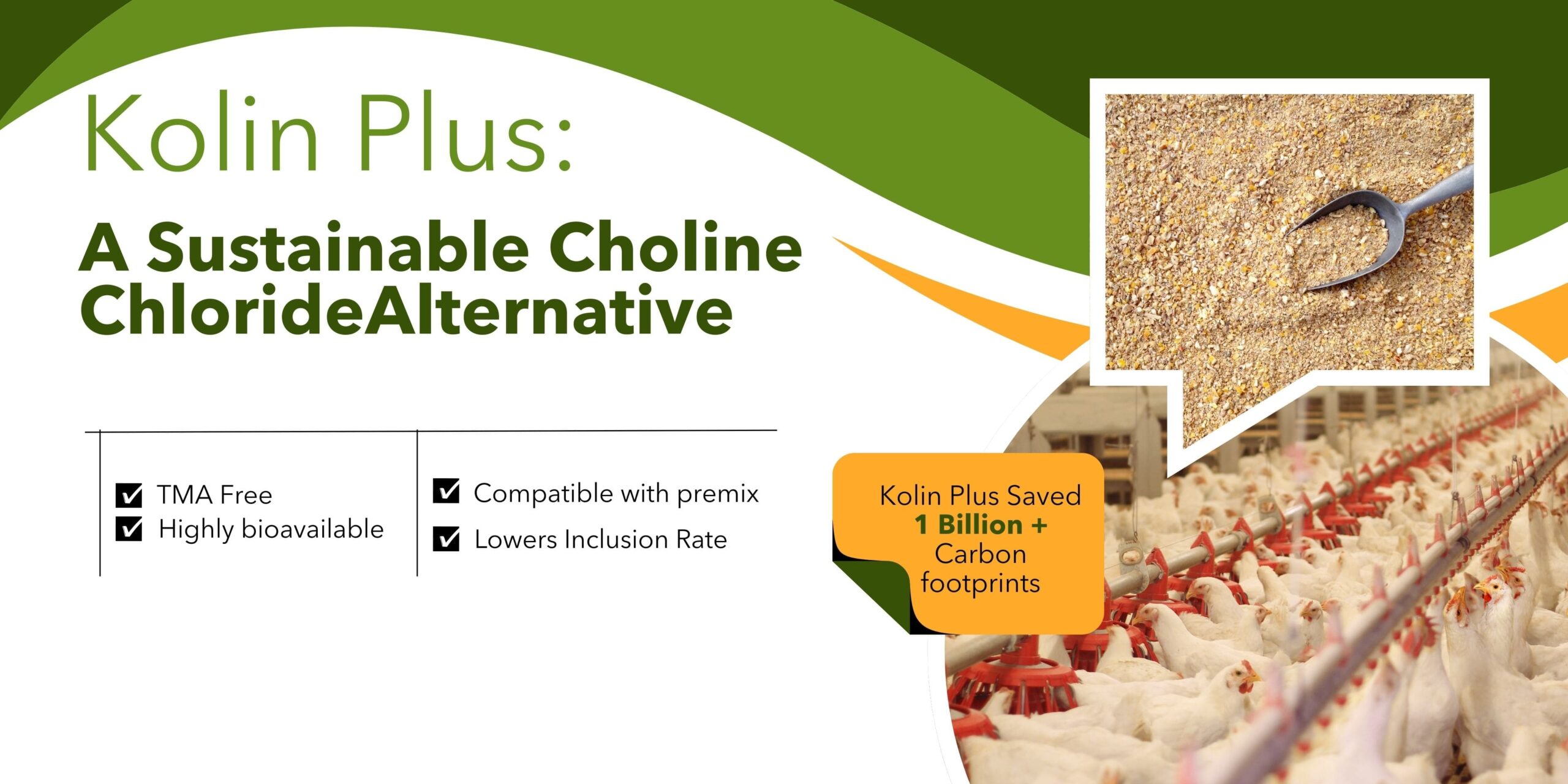Choline, a B-complex vitamin also known as vitamin B4, has been revived as a vital “feed additive” in poultry.
As a lipotropic factor, choline aids in fat mobilization and prevents fatty degeneration. In addition to this, choline plays several crucial roles in the bird’s body.
The metabolic requirements for choline are met through two main pathways:
- Dietary Choline
- Choline synthesis in animals
Although birds can synthesize choline, the amount produced is minimal. To optimize growth and performance, the diet must provide additional choline (NRC, 1994).
Free choline constitutes only a small portion of the total choline found in biological materials. The more common forms include:
- Lecithin
- Acetylcholine
In biological systems, choline primarily exists as a phospholipid, most commonly in the form of phosphatidylcholine (PC), also known as lecithin. Other significant intermediates in choline metabolism include phosphatidylethanolamine (PE) and sphingomyelin.
However, the dietary bioavailability of choline is considered “moderate” (Whitehead & Portsmouth, 1989; Baker, 1995).
The bioavailability of nutrients to poultry is mainly influenced by two factors:
- Stability in premixes, diets, and supplements
- Utilization efficiency
Soybean meal, regarded as an excellent source of choline for non-ruminants, offers a bioavailability of 60–75%, significantly higher than that of most other feed ingredients. In contrast, rapeseed meal has a bioavailability as low as 24% (Baker, 1995; Schutte, 1999).
History:
Choline was first isolated from hog bile by Strecker in 1862.
Chemical Structure:
Bayer identified the structure of choline in 1867.
Physical Characteristics:
Pure choline is a viscous, highly alkaline liquid. In poultry feed, it is typically used as choline chloride, which is soluble in both water and alcohol. Commercial preparations of choline chloride generally consist of a 50-60% aqueous solution mixed with a dry carrier.
Natural Sources of Choline: Choline can be found in fish meal, soybean meal, yeast, and various oilseeds, such as peanuts, cottonseed, and soybeans.
Functions of Choline Chloride:
- Synthesizes acetylcholine
- Acts as a methyl donor for methionine synthesis in the body
- Plays a crucial role in fat mobilization, helping to:
- Prevent fatty liver syndrome
- Serve as a source of labile methyl groups
- Synthesize acetylcholine, a neurotransmitter
- Contribute to plasma membrane structure
- Prevent hemorrhagic kidney lesions
- Prevent perosis in chicks
Deficiency Symptoms:
- Poor growth
- Perosis, characterized by an abnormal posture in birds
- Fatty degeneration of the liver and kidneys
Choline Requirements: The requirement for choline depends on the levels of folic acid, vitamin B12, and methionine in the feed. Low levels of these nutrients can increase the need for choline. Practical requirements are as follows:
- Commercial Broilers:
- Choline (mg/kg, added): 900
- Choline (kg/ton of feed): 0.9 to 1.5 kg (depending on ether extract percentage in feed)
- Commercial Layers:
- Choline (mg/kg, added):
- Chick mash: 600
- Grower mash: 250
- Layer mash: 500
- Choline (mg/kg, added):
Limitations of Synthetic Choline Chloride: The efficacy of synthetic choline chloride can be reduced by interactions with feed ingredients or additives, gut infections, liver dysfunction, and phospholipid deficiencies. Additionally, trimethylamine (TMA), a key component in choline production, must be neutralized in the final product. If not properly neutralized, TMA’s corrosive nature can damage the intestinal lining and cause malabsorption.
To ensure quality, synthetic choline chloride should:
- Contain less than 250 ppm of TMA (nephrotoxic and hepatotoxic)
- Be free from PCBs (polychlorinated biphenyls)
- Be free from radioactive elements, such as Cs-137
- Have a moisture content below 3%
- Be free of dioxins
- Be non-GMO, as the base is often corn cob
- Be free from mycotoxins and bacterial toxins, as corn cob is susceptible to them
- Contain heavy metals (Pb, Cd, As, Hg) at less than 12 ppm
- Interact with vitamins and ionophores
- Be poorly absorbed in the GI tract due to its quaternary base
- Be corrosive, which can damage equipment and pose handling challenges
- Have an unpleasant odor, which is a concern in processing units and feed mills
Stoichiometry of Choline Chloride:
- Dry Choline Chloride (60% concentration):
- 1 kg of 60% dry choline chloride contains at least 450 g of choline (45% choline content)
- Aqueous Choline Chloride (75% concentration):
- 1 kg of 75% aqueous choline chloride contains at least 560 g of choline (56% choline content)
Choline content in rice DDGS ranges from 1750-1850 mg/kg in varieties with protein levels of 38-44%, while pure rice DDGS with protein levels of 53-55% contains about 2500-2700 mg/kg.
We must also consider the bioavailability of choline. For instance, rapeseed contains 1650 mg/kg of choline, but only 24% of it is bioavailable
Conclusion:
Choline, an essential B-complex vitamin, serves as a key “feed additive” in poultry for fat mobilization and the prevention of fatty degeneration. It plays various crucial roles in avian metabolism, making dietary supplementation necessary for optimal growth. Natural sources include fish meal, soybean meal, and yeast. Choline chloride, widely used in poultry feed, aids in synthesizing acetylcholine, prevents fatty liver syndrome, and provides labile methyl groups. A deficiency can lead to poor growth, perosis, and fatty degeneration. However, synthetic choline chloride has limitations, such as potential toxicity, corrosiveness, and interactions with other ingredients. The choline content and stoichiometry in different feed components highlight its importance in poultry nutrition.








.png)












.png)

.png)








